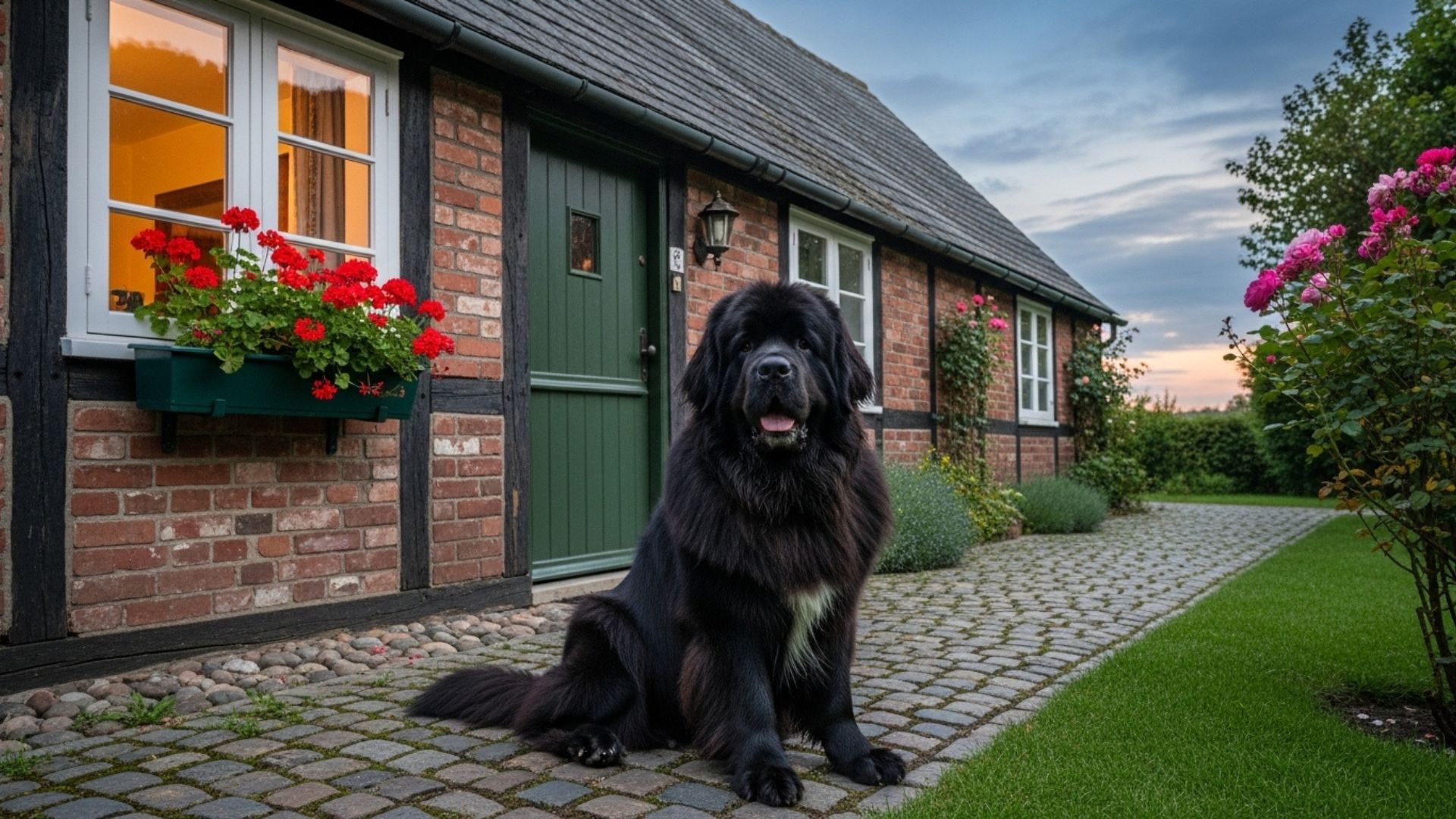When it comes to safeguarding your home, size often matters. Giant dog breeds, with their imposing stature and natural protective instincts, are increasingly sought after for home security. Dogs in the Working Group are bred for strength, vigilance, and guarding capabilities.
However, owning a giant guard dog comes with responsibilities. Proper training and socialization are crucial to ensure they are well-behaved and can distinguish between normal and suspicious activities. Without consistent training, even the most protective dog can become a liability.
In this guide, we’ll explore some of the best giant dog breeds known for their guarding abilities, providing insights into their characteristics, training needs, and suitability for various living environments.
Best Giant Dog Breeds To Guard Your Home Efficiently
Here are the 9 giant guard dog breeds:
1. Tibetan Mastiff
When it comes to the best giant dog breeds to guard your home efficiently, the Tibetan Mastiff stands out as a natural choice.
According to Hills Pet, with centuries of history as guardians of livestock in the harsh Himalayan mountains, these powerful dogs combine an imposing size with natural protective instincts, making them excellent at deterring intruders.
Today, they remain a striking presence in homes, offering both protection and unwavering loyalty to family members.
Key Facts at a Glance
Exercise Needs: Short bursts during the day, suitable for large properties
Energy Level: Moderate – balances activity with long rest periods
Longevity: 10–12 years
Drooling & Snoring: Moderate to high drool; loud snoring
Behavioral Traits: Territorial, digs holes to rest, moderate barking as a warning
Social Needs: Moderately playful, reserved with strangers, affectionate with family
Care & Considerations
Training & Socialization: Early training is essential to ensure proper behavior around strangers and other pets.
Grooming Needs: Thick coat requires regular brushing to maintain health and manage shedding.
Sourcing Your Dog: Prefer adoption from rescue organizations, or if purchasing, choose ethical breeders that prioritize temperament and health.
2. Anatolian Shepherd
For those seeking the best giant dog breeds to guard their home efficiently, the Anatolian Shepherd is a top contender. Originating from the Anatolia region of Turkey, this breed was developed over millennia to guard livestock against predators, making them naturally protective and fearless.
According to Orvis, their keen senses, combined with imposing size and alert demeanor, allow them to deter intruders and act as a formidable first line of defense, all while forming deep bonds with their family members.
Key Facts at a Glance
Coat: Short or rough double coat; seasonal shedding is heavy
Exercise Needs: Moderate – long walk or yard activity daily
Energy Level: Medium – intelligent breed benefits from mental stimulation
Longevity: 11–13 years
Behavioral Traits: Territorial, wary of strangers, can be aggressive with other pets
Social Needs: Strong attachment to family, cautious with outsiders
Care & Considerations
Training & Socialization: Early and consistent guidance is critical for this independent breed.
Grooming Needs: Daily brushing during shedding season; weekly brushing otherwise.
Health Considerations: Watch for hip and elbow dysplasia, hypothyroidism, and bloat; regular vet checks recommended.
Suitable Living Environment: Best for homes with large outdoor spaces; not ideal for small children or homes with multiple pets.
3. Kuvasz
For those seeking the best guard dog to protect a home efficiently, the Kuvasz is a naturally imposing choice. This snow-white giant from Hungary has been naturally inclined to guard livestock and property for centuries, combining intelligence, strength, and a protective nature that makes it highly effective at deterring intruders.
While historically a working dog for farmers and kings, the Kuvasz today thrives in a family environment that can provide consistent training and space for daily activity.
Key Facts at a Glance
Coat: Thick medium-length double coat; straight to wavy
Exercise Needs: Medium – daily walks or yard activity for at least an hour
Energy Level: Medium – moderate exercise keeps them engaged
Longevity: 10–12 years
Behavioral Traits: Protective, calm, affectionate, wary of strangers
Care & Considerations
Training & Socialization: Early, consistent training is critical to managing stubbornness and protectiveness.
Grooming Needs: Moderate grooming; regular brushing keeps the coat healthy and manages shedding.
Suitable Living Environment: Best suited for homes with large, fenced yards; not ideal for apartments.
Health Considerations: Generally healthy, but watch for hip and elbow issues; routine vet care recommended.
4. Great Dane
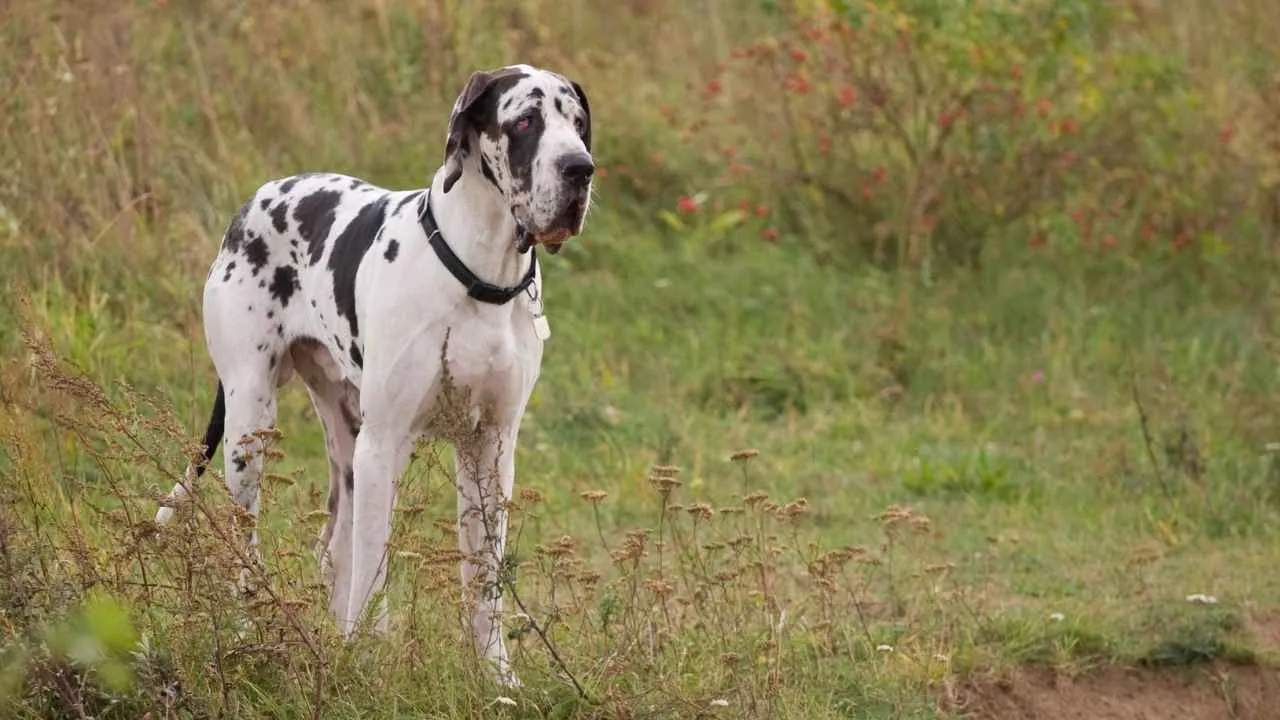
When it comes to the best giant dog breeds to guard your home efficiently, the Great Dane stands out as both a commanding presence and a devoted protector. Originally bred in Germany for hunting wild boar and guarding royalty, this breed combines elegance with an imposing physique that can deter intruders before they even set foot inside.
According to PetMD, they are known as the “Apollo of dogs.” Great Danes pair a regal stature with a calm, watchful demeanor—making them a fitting choice for families seeking both security and companionship.

Key Facts at a Glance
Coat: Short, sleek coat requiring minimal grooming
Exercise Needs: Moderate – daily walks and playtime keep them fit
Energy Level: Low to moderate – calm indoors, active outdoors
Longevity: 7–10 years
Behavioral Traits: Protective, calm, affectionate, dignified
Social Needs: Deeply bonded with family; enjoys companionship and attention
Care & Considerations
Training & Socialization: Begin early to channel their protective nature positively.
Grooming Needs: Weekly brushing keeps their coat healthy and clean.
Suitable Living Environment: Requires a spacious home or yard; not suited to small apartments.
5. Newfoundland

When it comes to giant dog breeds that can guard your home efficiently, the Newfoundland stands out for its combination of incredible loyalty and natural protective instincts. While they are famously gentle, these dogs don’t hesitate to alert their owners when something’s amiss.
Their imposing size alone can be enough to deter intruders, but paired with the right training, Newfoundlands can become both loving family members and great guard dogs.
Their calm confidence means they can distinguish between a genuine threat and harmless visitors, making them reliable companions for households with children, guests, and even other dogs.
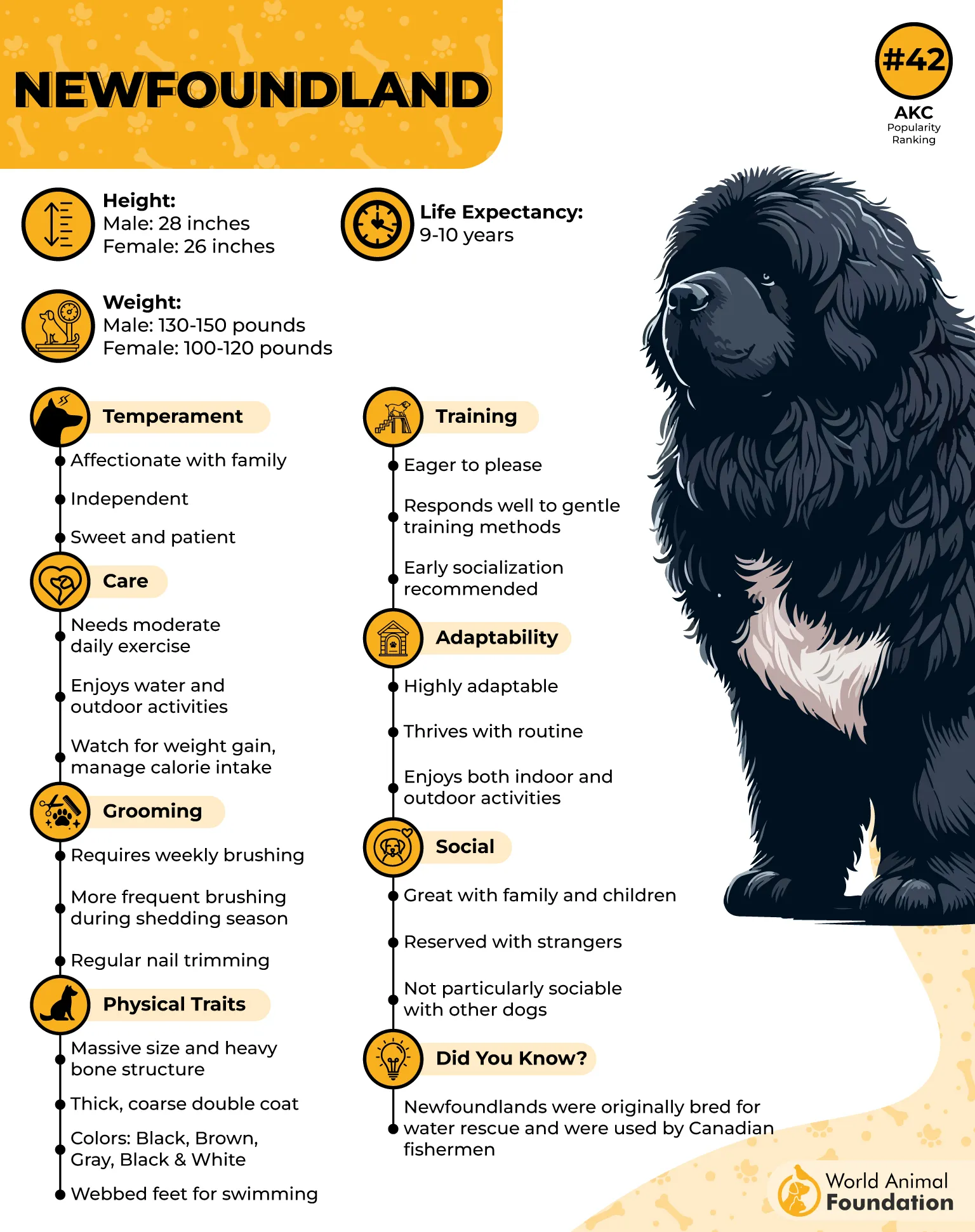
Key Facts at a Glance
Coat: Thick, medium-length double coat in black, brown, gray, or Landseer
Exercise Needs: Medium – daily walks and swimming if possible
Energy Level: Low to medium – relaxed indoors, active outdoors
Longevity: 9–10 years
Behavioral Traits: Gentle, loyal, protective, patient
Social Needs: Excellent with family and other pets; early training enhances manners
Care & Considerations
Training & Socialization: Positive reinforcement works best; early leash training is essential given their size.
Grooming Needs: Weekly brushing; more during shedding seasons.
Suitable Living Environment: Best for homes with space and access to a yard; thrives in cooler climates.
6. Leonberger
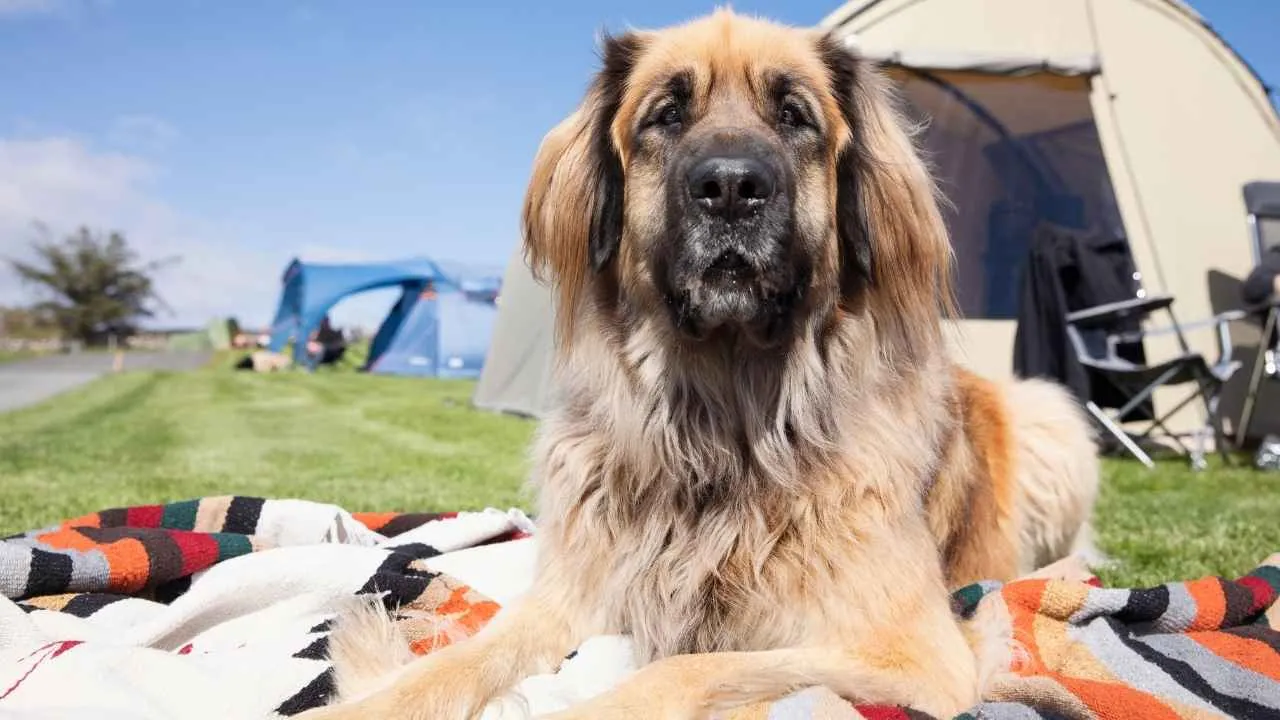
Despite their massive size and powerful build, Leonbergers are calm, affectionate, and deeply bonded with their families. Originally bred in the 1840s to resemble the lion on the Leonberg town crest, this breed combines the strength of the Newfoundland, the St. Bernard, and the Pyrenean Mountain Dog.
They make excellent guard dogs due to their natural protectiveness and imposing presence, but with basic obedience training, they’re also gentle companions that can adapt well to family life.
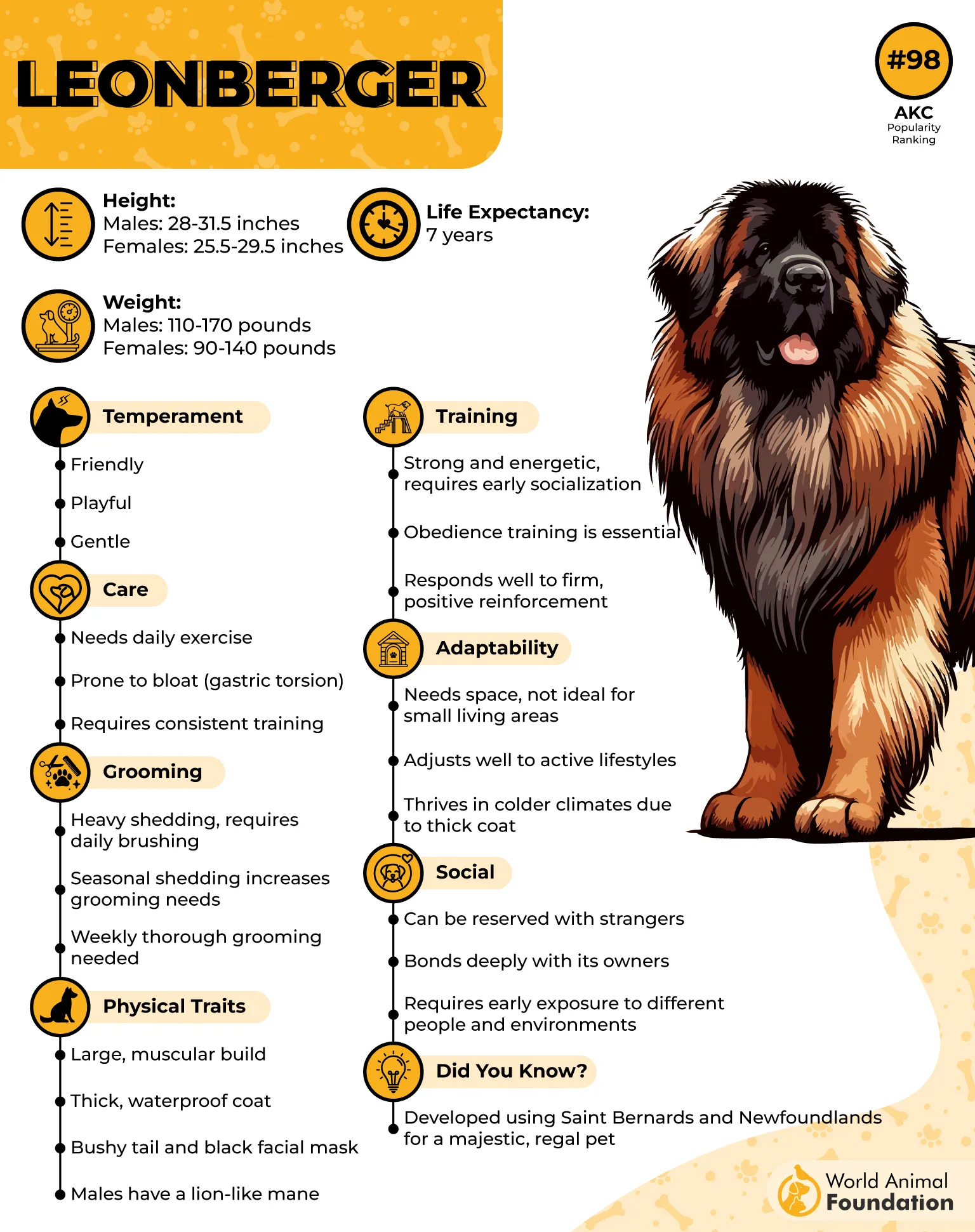
Key Facts at a Glance
Coat: Long, dense double coat in shades from sandy to reddish-brown, with a black mask
Exercise Needs: Medium to high – at least an hour of daily activity
Energy Level: Medium – relaxed indoors, energetic outdoors
Longevity: 8–9 years
Behavioral Traits: Protective, calm, loyal, affectionate
Social Needs: Requires early training to live peacefully with kids and other pets
Care & Considerations
Training & Socialization: Basic obedience training is essential to channel their strength and guarding instincts.
Grooming Needs: Daily brushing to manage shedding and maintain coat health.
Suitable Living Environment: Best for experienced owners with space; thrives in cooler climates.
7. Neapolitan Mastiff
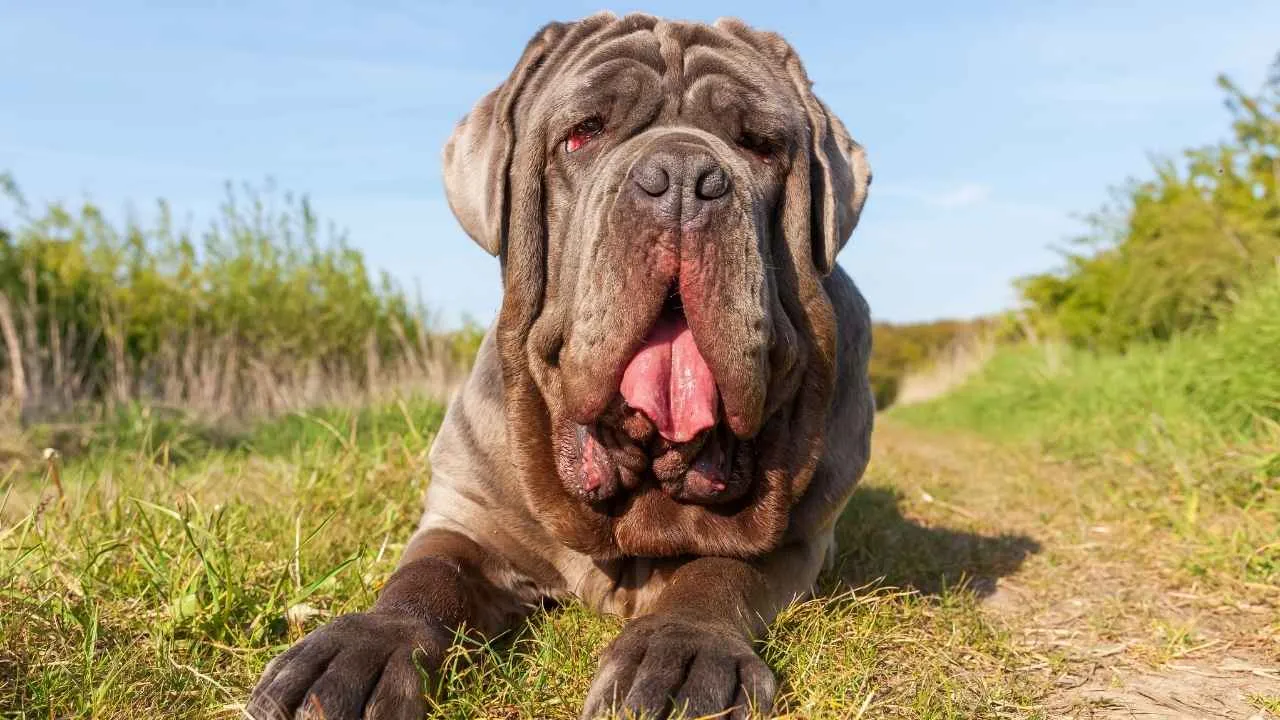
Despite their colossal frame and powerful build, Neapolitan Mastiffs are calm, loyal, and deeply devoted to their families. Beneath their imposing exterior lies a gentle and affectionate nature, especially toward children and loved ones.
With roots tracing back to ancient Rome, this breed’s physical presence and naturally suspicious temperament have long made it a formidable guardian. While they are highly trainable, early socialization is essential to balance their protective instincts with a well-mannered, peaceful demeanor.
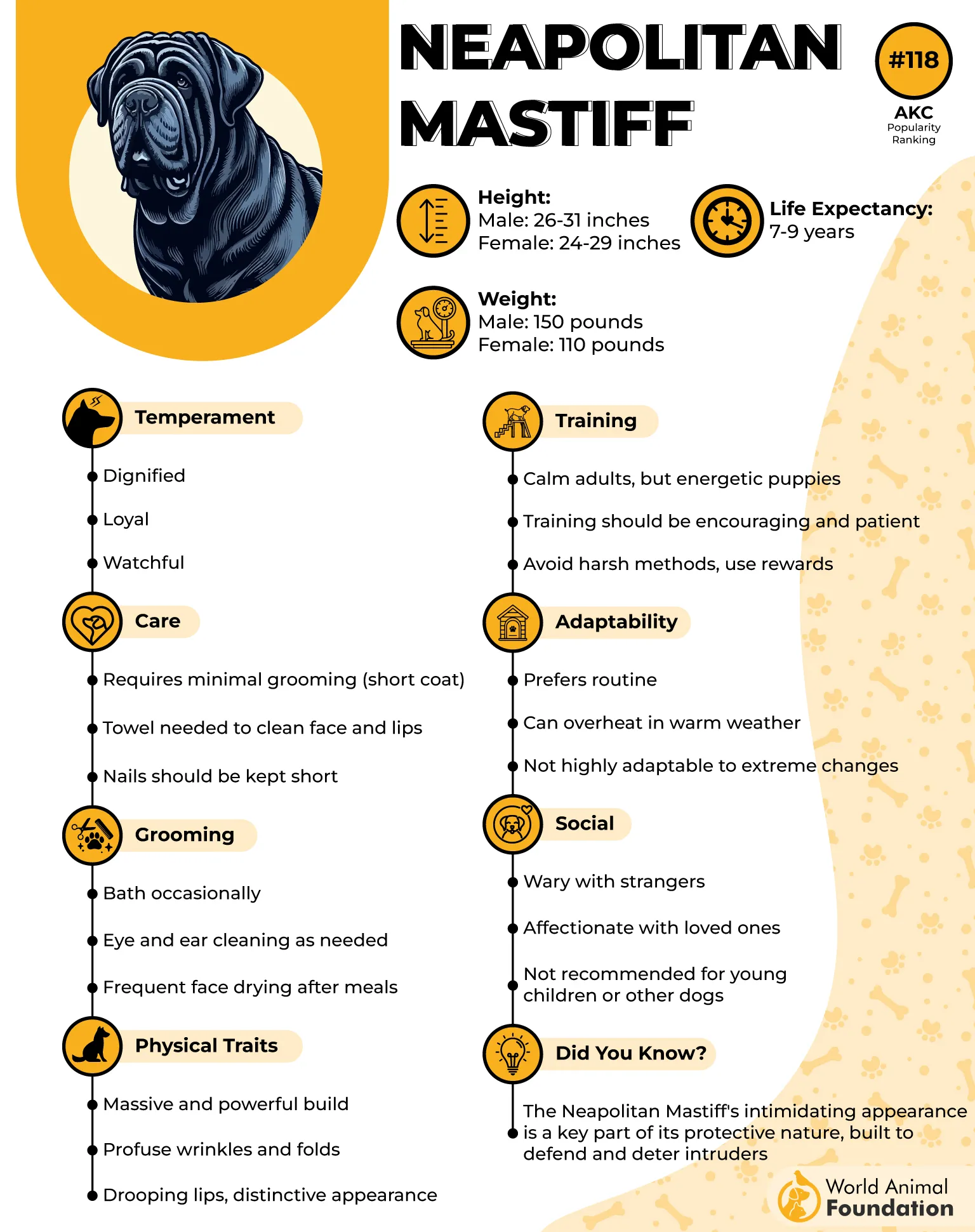
Key Facts at a Glance
Coat: Short, dense coat in blue, black, mahogany, or tawny; may have brindle patterns or white markings
Exercise Needs: Low to moderate – daily walks and light activity
Energy Level: Low – prefers calm, steady routines over high-energy play
Longevity: 7–9 years
Behavioral Traits: Protective, affectionate, independent, sometimes stubborn
Social Needs: Early training and exposure to other dogs and people are crucial
Care & Considerations
Training & Socialization: Start young to manage their size, strength, and territorial nature.
Grooming Needs: Low-maintenance coat, but skin folds require regular cleaning.
Suitable Living Environment: Best for spacious homes with secure yards; not ideal for apartments.
8. Great Pyrenees
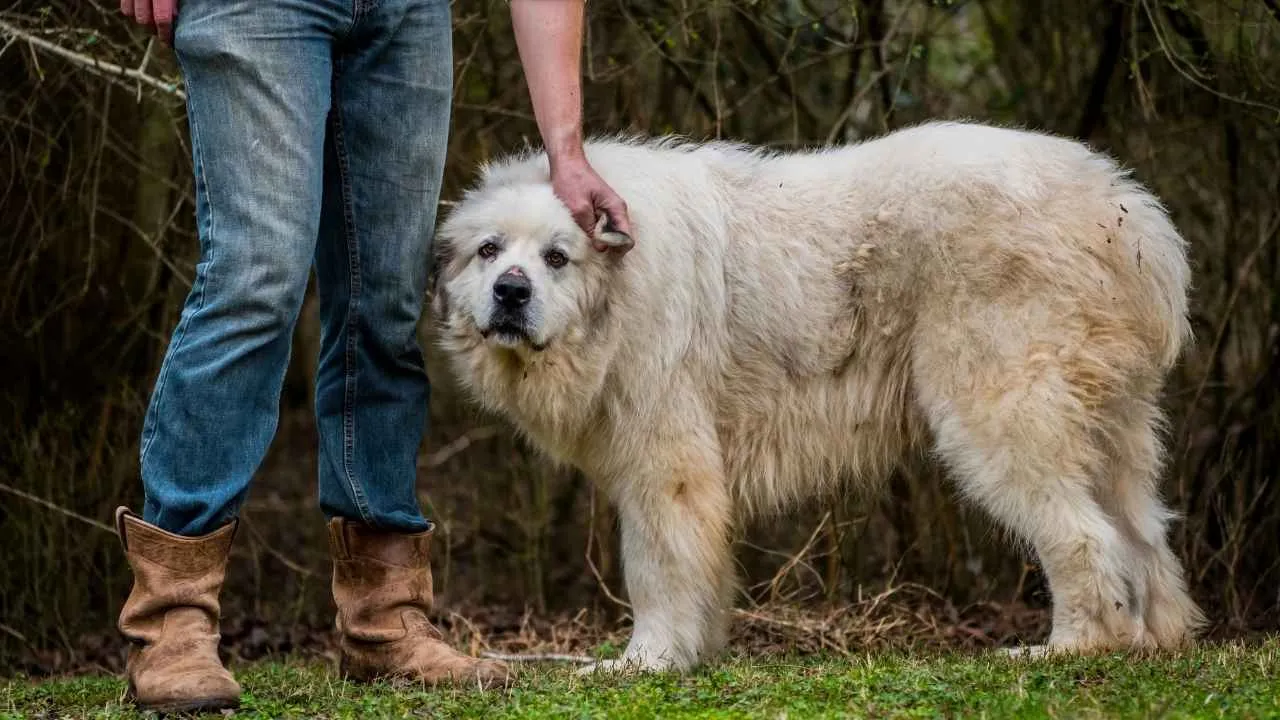
The Great Pyrenees is a majestic, large-boned guardian with a calm, steady presence and a deeply friendly nature. Known for centuries as protectors of flocks in the Pyrenees Mountains, these dogs combine quiet affection with a strong instinct to defend their home and family.
They’re the right breed for owners who appreciate a loyal, watchful companion that thrives in a peaceful, predictable environment.
While their independence can make training a challenge, their high intelligence and devotion make the effort worthwhile. With daily exercise, consistent guidance, and plenty of socialization, the Great Pyrenees is both a trustworthy guardian and a gentle family member.
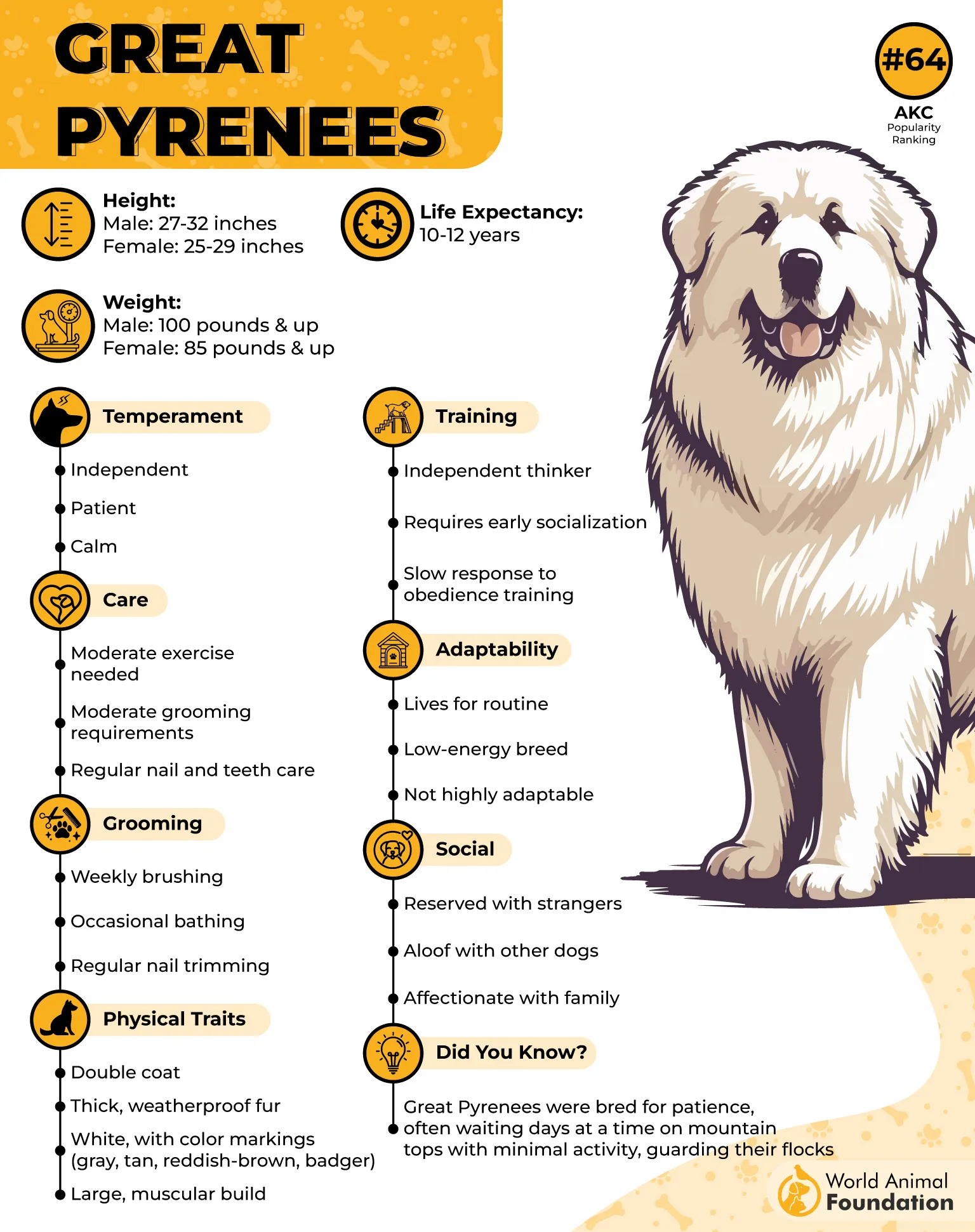
Key Facts at a Glance
Coat: Long, coarse outer coat; soft, dense undercoat; white or white with pale yellow, tan, or gray patches
Exercise Needs: Moderate – walks and outdoor play daily
Energy Level: Low to moderate – enjoys calm routines
Longevity: 10–12 years
Behavioral Traits: Protective, patient, independent, gentle
Social Needs: Early exposure to people and pets to balance guarding instincts
Care & Considerations
Training & Socialization: Patience is key; firm, consistent leadership works best.
Grooming Needs: Regular brushing to manage shedding, especially during seasonal coat blows.
Suitable Living Environment: Best for suburban or rural homes with space to roam.
9. Spanish Mastiff

The Spanish Mastiff is a giant, dignified guardian with an intimidating appearance and a calm, steady temperament. Originally bred to protect livestock from wolves and other predators, this breed is the perfect match for owners who value a watchful protector that is as devoted as he is imposing.
While he prefers observing from the sidelines over playful antics, his loyalty runs deep, especially in males who tend to bond closely with their families.
Though he snores loudly and slobbers generously, those who can look past these quirks will find an excellent companion and a steadfast defender of home and property.
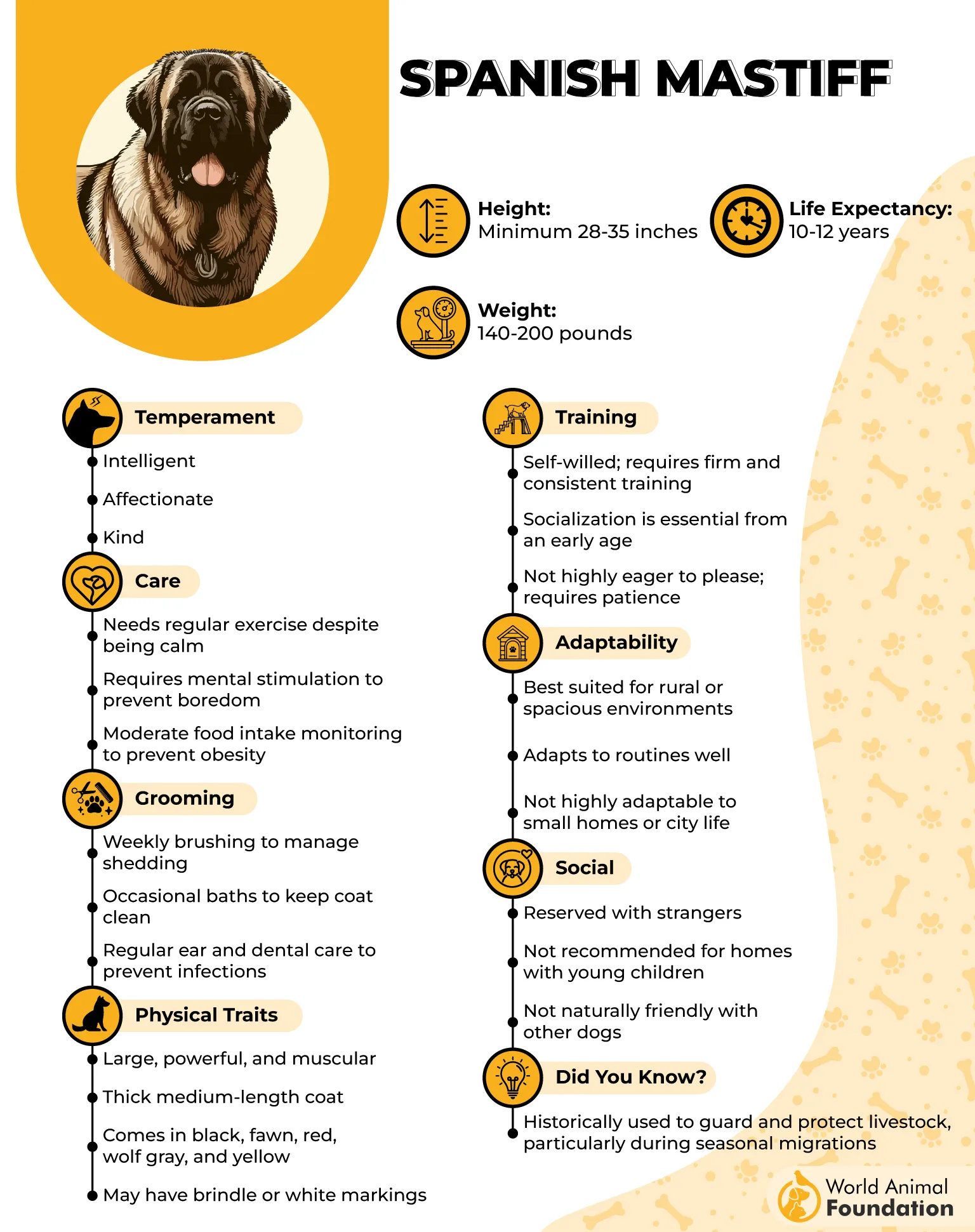
Key Facts at a Glance
Coat: Short, dense double coat with a harsh top layer and woolly undercoat; colors include white, black, fawn, brindle, red, wolf-sable, and yellow – solid or with white base and markings
Exercise Needs: Low to moderate – enjoys daily walks and outdoor patrols
Energy Level: Low – prefers calm routines and open spaces
Longevity: 10–12 years
Behavioral Traits: Protective, reserved, loyal, patient
Social Needs: Benefits from early socialization to temper aloofness toward strangers
Care & Considerations
Training & Socialization: Consistent, calm leadership works best; independence may require patience in training.
Grooming Needs: Weekly brushing; more frequent during seasonal shedding.
Suitable Living Environment: Ideal for rural or suburban homes with secure fencing and space to roam.
Conclusion
When it comes to protecting your property, the best giant dog breeds bring more than just size — they combine an imposing presence with the kind of temperament that makes them incredibly loyal to their families. Many of these dogs have histories that go far beyond guarding homes, excelling in roles from tracking large game to performing military work with precision and courage.
They thrive when given structure, a clear purpose, and regular exercise to keep both their bodies and minds sharp. With the right training and environment, these majestic protectors aren’t just formidable deterrents — they become lifelong guardians who stand watch with unmatched devotion.


